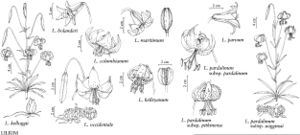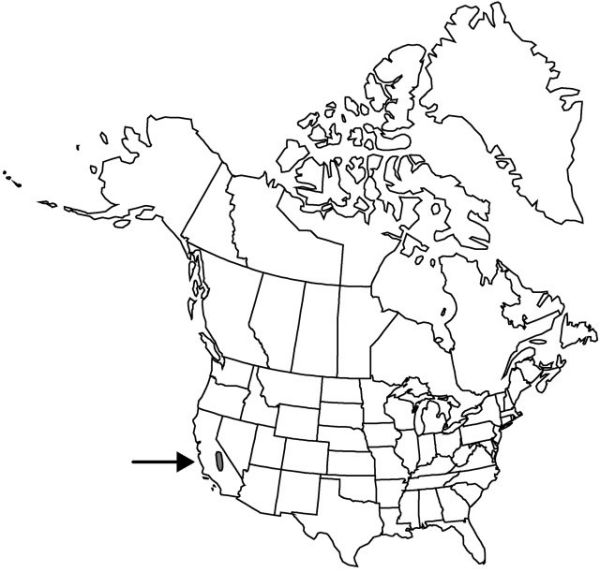Lilium kelleyanum
Sierra Club Bull. 4: 300. 1903.
Bulbs rhizomatous, unbranched, continuously scaly, 1.4–3.1 × 3.8–8.2 cm, 0.3–0.6 times taller than long; scales 2–3-segmented, a few unsegmented, longest 0.8–2.7 cm; stem roots absent. Stems to 2.2 m. Buds rounded in cross section. Leaves scattered or usually in 1–4 whorls or partial whorls, 3–10 leaves per whorl, horizontal and drooping at tips, 7.8–15.8 × 1.1–5.3 cm, 3.2–10.8 times longer than wide; blade usually elliptic, occasionally weakly lanceolate or oblanceolate, margins not undulate, apex narrowly acute; veins and margins ± smooth abaxially. Inflorescences racemose, 1–15(–25)-flowered. Flowers pendent, mildly fragrant; perianth Turk’s-cap-shaped; sepals and petals reflexed 2/5 along length from base, yellow or yellow-orange, usually with copious maroon spots, not distinctly clawed; sepals not ridged abaxially, 4.3–5.7 × 0.9–1.5 cm; petals 4.2–5.7 × 0.9–1.5 cm; stamens moderately exserted; filaments moderately spreading, diverging 9°–19° from axis; anthers magenta or dull red, 0.3–0.6 cm; pollen pale orange, rust, orange, or tan-orange; pistil 2.6–3.4 cm; ovary 0.8–1.4 cm; style green; pedicel 8.5–20.7 cm. Capsules 1.5–2.9 × 1–1.9 cm, 1.1–2 times longer than wide. Seeds 96–169. 2n = 24.
Phenology: Flowering summer (Jul–Aug).
Habitat: Hillside seeps, wet thickets, along streams in coniferous forests
Elevation: 2200–2900 m
Discussion
Lilium kelleyanum has in common with L. parvum a short, relatively wide fruit and small flowers, and divides with that species the montane and subalpine Sierra Nevada on both sides of the divide from Lake Tahoe south. The two species are parapatrically distributed with an intervening zone of introgression; intergrades occur, among other places, in the June Lake region about ten miles south of Mono Lake in Mono County and in adjacent Madera County. The two species appear to be sister taxa (M. W. Skinner 1988), which argues against subsuming L. kelleyanum as a subspecies of L. pardalinum, as has been suggested by several students of the group. Despite the close affinity of L. kelleyanum to L. parvum, taxonomic custom within the genus dictates that they be retained as separate species since floral features are well differentiated.
Lilium kelleyanum is pollinated by swallowtail butterflies (J. S. Davis 1956).
Selected References
None.

